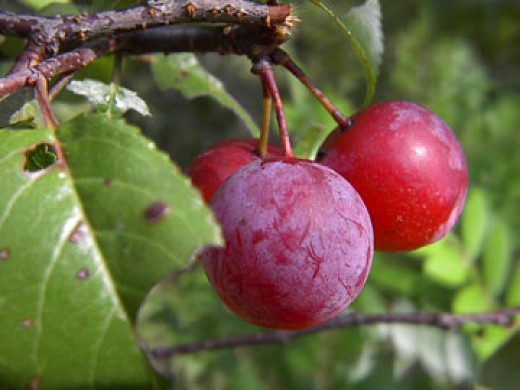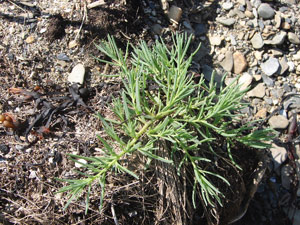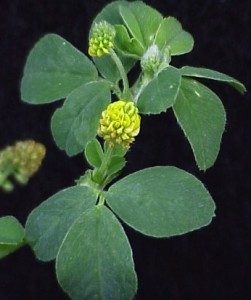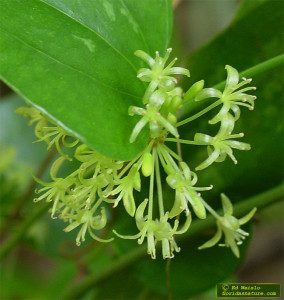This was “Prunus” foraging week. While rummaging around our usual class location in Jacksonville we sampled Black Cherries and Chickasaw Plums. Both are just beginning to ripen but there were enough for every one to have a taste. There’s a lot of competition for the Black Cherries from the birds. The Chickasaw Plums were more available but not quiet as ripe. Although they are cherries and plums both fruits are in the same genus, Prunus so it was not surprising they are ripening at the same time. The cherries don’t stay around long but the plums should be ripening for another six weeks or so. To read about the Black Cherry go here, the Chickasaw Plum, here.
Also in Jacksonville we dug up two Winged Yams. Well… I dug up one and a student dug up another. If you know where they grow this is a good time to wrench those tasty yam from the ground (and they are true yams, not at all related to sweet potatoes what are not yams but are marketed in the South as “yams.” Spring roots are full of starch from last season and are just putting on shoots. They’ll used that stored energy to climb to the top of the trees, reproduce, and put on an even bigger root for next year. Right now the shoots around a few inches to a yard long. The two we dug up weighed around one pound and two pounds, shaped like a two-liter soda bottle. They are boiled like potatoes. No wild edible in Florida produces so many calories for such little work. They are our prime caloric staple. To read about the Winged Yam click here.
Foraging south of Daytona Beach uncovered some very tasty salt-tolerant plants on the inner coastal waterway. Spring is always a good time for finding the greens that come pre-seasoned. The most outstanding, and also the only seasonal one, is Sea Blite. Related to Lambs Quarters, it’s a mild tasting and mildly salty green that’s just coming into season. It’s my candidate for a commercial crop it is so good. Edible raw or cooked I like to catch a fish on the inner coastal water way, stuff it with Sea Blite, then cook it there and there. The salt leaves the Sea Blite and helps to flavor the fish. You end up with a scrumptious fish and delectable steamed greens. Truly a gourmet meal on a foraging budget. Sea Blite is found on inner coastal waters rather than on the beach side. Inland it is found in salty areas such as salt lick even along heavily salted roads in northern areas. To read about Sea Blite go here.
You’re probably seeing a lot of this here and there right now and you’re wondering what it is. The little plant with the little yellow blossom is probably Black Medic. It is generally considered edible and like many weeds is from Europe. That kind of excludes it from being a significant Native American food (though some sources call it an “Indian” food.) The headache is that from a distance of about five or six feet (where most people’s eyes are from the ground) it can look like Hop Clover. Here’s quick way to tell them apart: Hop Clover tends to have red stems, Black Medic has green stems covered with fine white hair. I personally don’t view Black Medic as much of an edible but you can read more about it here.
During your woodland travels are you seeing a vine with greenish-blossoms (not white) that look like a pompom? That might be smilax which is blooming now. (Poison Ivy has white blossoms but with yellow to brown centers.) There are about 12 species of smilax locally and around 24 east of the Rockies. Some of them can be hard to tell apart. Here’s two that resemble each other: Smilax auriculata and Smilax bona-nox. S. auriculata usually grows in dry sandy areas along the coast. S. bona-nox has a wide range of habitats. S. auriculata has an umbel stalk that is only half as long as a leaf petiole. The stem and prickles are hairless. The berries have two or three seeds. S. bona-nox’s umbel stalk is the same length as a leaf petiole. Its lower stems and prickles are hairy. The berries have one seed. S. bona-nox also has prickles on the leaf margins. It can take up to 18 months for the berries to ripen and turn black. They usually don’t taste acceptable until the berries shrivel some and resemble raisins. You can read more about Smilax here.
There wasn’t a Green Deane Newsletter last week’s because the time allotted for it was spent making a new video, my 140th this time about Wild Garlic/Onions. To view it click here.
You can read past newsletters by going to the main website (EatTheWeeds.Com) and typing NEWSLETTER in the search window then pressing the enter key. Then click on the title you want to read.







hello MR dean
what are pear leaf good for
Looking at. Do not eat them.
Hi Green Deane,
Is there a survival/famine staple in the Everglades?
Dioscorea alata comes to mind… cattail, sawgrass, ground nuts… read my article on finding caloric staples.
I’ve really missed the last issue of Eattheweeds Newsletter though I appreciate very much the good effort exploited in preparing the new video on “Wild Garlic/Onion”. I’ve watched the video eagerly and I’ll repeat watching it as I’m hoping to grow garlic soon.
About root crops and with reference to http://www.fao.org/fileadmin/templates/agphome/documents/PGR/SoW1/africa/SUDAN.PDF
In my country Sudan, there are some cultivers of edible roots mainly as carbohydrate source . These include :Cassava (Manihot sp.) , Yam (Dioscorea sp. ) and sweet potato (Ipomca batatas ).As I remember the Cassava root should not be eaten raw due to cyanide poisoning. These plants are grown in western states and in the south and irrigated by rain water.They are also grown in irrigated regions in central Sudan.